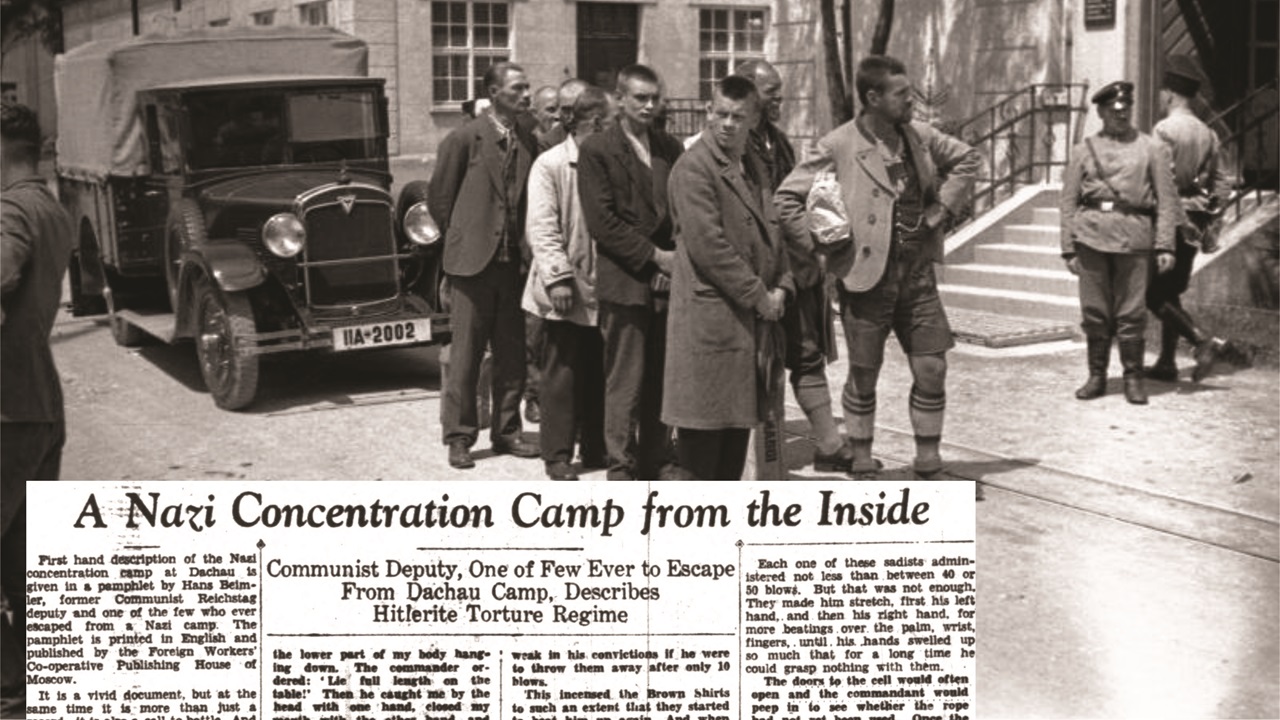
This article is part of the People’s World 100th Anniversary Series.
On March 22, 1933, the Hitler government opened its first concentration camp. Located near Munich in southern Germany, the Dachau Concentration Camp was constructed specifically to hold the Nazis’ chief political enemies—the Communists.
Others opposed to fascism—including trade union leaders, social democrats, and revolutionary workers—were also targeted for imprisonment in the new camp system. Jewish Communists were consistently treated much more harshly than other inmates, but torture and possible murder were the norm for everyone discarded behind the barbed wire.
It would still be several years before the Nazis began using the camps as industrial death factories in their attempt to systematically destroy the Jewish population of Europe generally, but Dachau showed the way. Though it remained a camp for political prisoners and slave laborers for much of its existence, Dachau served as a training center for SS camp guards, and its organization and processes became a model for all Nazi concentration camps.
The Daily Worker and Communist newspapers around the world were the first media outlets to report on the horrors unfolding in the Nazi camp system. The Daily Worker featured an article on Dachau’s opening the very next morning. In the coming weeks and months, its reporters and foreign correspondents tracked the escalating terror of the fascist government. The selection of 1933 articles below, which includes an early account from inside Dachau, provides an example of Communist journalism at its best.
By contrast, too many bourgeois press outlets were still treating the new Hitler government—which was only a few weeks old—as deserving a fair chance to turn Germany’s depressed economy around. They took note of the Nazis’ brutality, anti-Semitism, and political persecution, but editorial pages often relegated these to being secondary traits of fascism.
In the U.S. today, another racist and anti-Communist has mused about building concentration camps of his own to lock up migrants (again) and political opponents if he gets back into power. The struggle to defend democracy and resist fascism is as relevant today as it was in the 1930s.

Thousands of arrested workers’ leaders to be held in barbed wire enclosures
Daily Worker, March 23, 1933
BERLIN—Wilhelm Frick, Nazi Minister of the Interior, announced today that all the Communist Reichstag deputies arrested would be scattered in various concentration camps for political prisoners to be set up throughout Germany. They will not be allowed to attend the Reichstag sessions. Thousands of arrested Socialist and Communist leaders are overcrowding the Bavarian jails and are soon to be interned in barbed- wire concentration camps, the first of which has been established in Dachau, a small town near Munich, Chief of Police Himmler announced today. Himmler also announced that the Communist press was shut down forever, while the Socialist press would remain suppressed until April 4th.
—–
Murderers immune
Daily Worker, March 23, 1933
OLDENBURG, Germany—The Nazi stormtroopers who waylaid and assassinated the Communist Deputy Gordes will not be prosecuted, the Minister of Justice announced here today. He stated that “their act was a deed of national resurgence” and did not deserve criminal punishment.
—–
Inhuman tortures in Dachau Concentration Camp near Munich
Daily Worker, May 31, 1933
FRANKFURT—Inhuman torture is still going on in the Dachau Internment Camp near Munich, the biggest concentration camp in Germany, where some 5,000 workers and intellectuals are confined.
The prisoners are divided into three classes. All leaders of working-class organizations are in Class 3. They are locked up in cellars, without beds, tables, or chairs, without even blankets to cover them. The floor is covered with pools of water. These comrades in Class 3 are beaten every day with a riding whip.
The Secretary of the Bavarian District of the Communist Party, Comrade Hans Beimler, was atrociously beaten by the fascists. After another comrade, Dressler, had been murdered, the Nazis threatened Beimler, telling him his last hour had come. They tortured him for hours and then brought him a rope, saying he should do the same “as the other fellow did. At 8 o’clock, you must be dead, you dirty dog, or else we shall come. Your last hour on Earth is near.”
Thus the Nazis prepared to assassinate Comrade Beimler. That very night, Beimler succeeded in making his escape, clothed only in underwear. The Munich Chief of Police has offered a reward for his recapture, but Beimler is now in safety.
—–
Nazis murder 37 in Dachau prison camp

Concentration camps being enlarged
Daily Worker, June 9, 1933
MUNICH—Two Communists were shot in the Dachau concentration camp during the night of May 20 “while trying to escape.” The total of “suicides” or those shot “while attempting to escape” in the Dachau camp has now risen to 37.
A delegation of foreign journalists, most of them correspondents of obscure fascist Balkan newspapers, are being shown around Germany to refute reports of fascist terror there. They were shown the Bayreuth Theatre, Wagner’s tomb, the new hotel on the Zugspitze Mountain, and some Munich museums. Then, they were told to write to their papers that they didn’t notice any terror at all.
But even as these journalists were not completely satisfied with the things they were shown, a short visit to the Dachau internment camp was arranged. Everything would have been in order but for an “accident.”
The day following their visit, the Communist Hausmann was shot “while trying to escape.”
It is a curious coincidence that Hausmann had spoken to one of these journalists in English and had given him a true report on the terrible conditions in the camp.
…
The Nazi newspaper Angriff of Berlin reported May 20 that “the Oranienburg concentration camp [Sachsenhausen] for political prisoners has been taken over by the Federal government and will be enlarged considerably.”
This report gives the lie direct to the same Angriff and other fascist papers which reported shortly before May 1 that most of those interned would be released and that the government would resort to “protective arrest” less frequently in the future.
—–
Beheading of four Communists
Nazis inaugurate gruesome device to create terror

Daily Worker, Aug. 3, 1933
ALTONA, Germany (Aug 1)—At dawn yesterday, a Nazi executioner beheaded four heroic Communists of Altona. They are August Luettke, seaman; Walther Mueller, laborer; Karl Wolff, shoemaker; Bruno Tisch, plumber.
They were among the workers arrested on “Bloody Sunday,” July 17, 1932, when thousands of Nazis invaded Altona, a working-class suburb of Hamburg, with the approval of Schoenfelder, the Social Democratic chief of police, and made a bloody attack on workers.
In the cold dawn, while witnesses shivered, the workers were brought out one by one, their hand tied behind their backs.
The state’s attorney read to each the decision of the special court which had decided their judicial murder.
Then, the executioner, in full evening dress, gave a signal to his assistants, who threw each in turn face downward over a narrow plank. The executioner released a heavy cleaver-life knife, which dropped to the plank.
This gruesomely spectacular method of judicial murder is designed to strike the workers of Germany with terror. Premier Hermann Goering of Prussia refused to commute the sentences, declaring that the terror of beheading is necessary to suppress the increasing resistance of the workers to fascism.
In Prussia, Goering has decided that the beheading of Communists is to be carried out with medieval gruesomeness, with a head block and a hand-swung axe.
This is the fate which awaits Ernst Thaelmann, Ernst Torgler, Georgi Dimitrov, Vassil Taneff, Blagoi Popov, and many other Communist leaders if the mass pressure of the international working class does not prevent their conviction, or save them from extra-legal death by torture in the Nazi prisons where they are held.
—–
A Nazi Concentration Camp from the Inside
Daily Worker, Oct. 19, 1933
First-hand description of the Nazi concentration camp at Dachau is given in a pamphlet by Hans Beimler, former Communist Reichstag deputy and one of the few who ever escaped from a Nazi camp…. It is a vivid document, but at the same time, it is more than just a record—it is also a call to battle. An in this lies its value.
Hans Beimler was the leader of the South Bavarian District of the German Communist Party. When, in March 1933, the Bavarian People’s Party surrendered the government to the Hitlerites, the order was given to arrest immediately all the active Communist Party members. This was done, though the fascists failed to arrest them all.
The Communists succeeded in carrying on their activities underground, and that fact made the Brownshirts more inhuman in their treatment of those who fell into their hands. Beimler describes his own experience with them.
“Suddenly, an automobile stopped in front of my house, from which six troopers wearing civilian clothes jumped out and arrested me and a friend of mine who was then in my room. I was immediately identified and led away to the headquarters of the Munich police. The first question they asked was: ‘What are you doing in the [Communist] Party?’
“‘I am the secretary of the Party’s regional committee, and I am a deputy of the Reichstag,’ I answered. ‘I have been for the third time elected by 60,000 Munich workmen.’ To this they replied: ‘We’ll make you forget that you were ever a Reichstag deputy.’”
Tortures followed immediately after the above deposition, and here is how Beimler describes them:
“After the deposition, we climbed up to the second story, where a tall trooper with a voice of a beast gave the command: ‘Take off your clothes.’
“They laid me on the table, with the lower part of my body hanging down. The commander ordered: ‘Lie full length on the table!’ Then, he caught me by the head with one hand, closed my mouth with the other hand, and ordered: ‘Give it to him!’
“The Brownshirts commenced beating me mercilessly and continued until I was rendered unconscious. I cannot remember whether I received 60 or 70 or more blows with a rubber club, but they did not stop beating me until I lost consciousness.
“When I came to myself, I was standing on my knees near the table, all in sweat. I was unable to keep myself on my feet, but one of the bandits cried out: ‘Hurry up, dress yourself, and be quick about it,’ and he was going to beat me again if I hesitated. I nearly cried from pain when my clothes touched my flesh. Everything was dark in front of me, but I succeeded in dressing.”
Beimler was then thrown into cell No. 14, which he had to share with many others. Every day some new people were brought in. Some would be led away to Dachau Concentration Camp; others would come to take their places. Without an exception, they were all beaten up and bruised. But all of them—Communist youth and veteran Communists, non-Party workers and peasants who opposed fascism, both young and old—withstood the treatment to the very end.
The fascists arrested a number of Party members who were working in a factory near Munich. Among them were many young Communists. They were led along with others to the torture cell and endured, as a beginning, 10 blows over the heels with the rubber club.
After this punishment, they asked one of the young Communists whether he was still for communism, to which he replied that he would have thought himself very weak in convictions if he were to throw them away after only 10 blows.
This incensed he Brownshirts to such an extent that they beat him up again. And when they repeated the question, he answered that they could beat him to death, that he would die for the Soviet Star. At this, they beat him up so mercilessly that he nearly died. There were many such cases, but this one will suffice as an example of that true heroism which the Communists have shown in the prison cells of the Third Reich.
With a number of others, Beimler was led from the torture cell to the Dachau Concentration Camp. More beatings. They beat him when he was brought in and on the way to the cell, and then again until he lost consciousness.
After beating him up once more, the commandant brought Beimler a rope and told him to climb up to the ceiling and tie the rope about the beam. It was at his disposal, the commandant said. But Beimler remained firm in his decision to endure it all to the end and make no use of the rope.
Beimler was awaiting further developments. He knew the attitude of workers and his own Party comrades toward suicide, that they regarded it as an act of cowardice, at any rate, an unrevolutionary act. His decision, therefore, was to endure to the end at all costs.
But the torture from that time on assumed a more excruciating character. Six bandits broke into his cell, and while four were beating him, the other two mocked him with the cries: “Rot Front [Red Front],” “Long Live Moscow,” Hail Thaelmann.” Writhing in pain, Beimler attempted to turn on his back; they beat him over his hands and feet so long that he had to turn on his stomach again.
Each one of these sadists administered not less than 40 or 50 blows. But that was not enough. They made him stretch, first his left hand, then his right hand, for more beatings over his palm, wrist, fingers, until his hands swelled up so much that for a long time he could grasp nothing with them.

The doors to the cell would often open and the commandant would peep in to see whether the rope had been used. Once the commandant seemed to have lost his patience, and remarked: “I’d like to know how long you will still hold out, you cowardly swine.”
Thus 14 days and nights were passed by Beimler in the concentration camp at Dachau. At the end of the 14 days, Beimler was given an ultimatum to end it all by the next morning. And if he was not going to do what was expected of him—“use the rope”—it would be done for him. But Beimler succeeded in escaping.
While he managed to escape the hands of the executioners, 50 other revolutionary workers of Bavaria were murdered in Camp Dachau.
Wherever the German proletariat lives, there, deep underground, goes on revolutionary work. Thousands of revolutionary pamphlets are being published and distributed. Nuclei meet secretly, and already echoes of underground revolutionary work are being heard on the street. The ground is shaking under the feet of the fascist rulers. The “Brown Terror,” that bloody companion of the fascist dictatorship, is not able to arrest or change the course of the revolutionary upheaval.
Beimler’s little book, which gives a picture of torture and cruelty inflicted on the revolutionary proletarians in the Dachau camp, is a witness to the fact that neither tortures nor the murders of the fascists will succeed in breaking the staunch and courageous revolutionary proletariat.
The fundamental problem before the Nazis, as dictated to them by the capitalists and landlords, is the destruction of the revolutionary workers’ movement. But this effort will fail.
We hope you appreciated this article. At People’s World, we believe news and information should be free and accessible to all, but we need your help. Our journalism is free of corporate influence and paywalls because we are totally reader-supported. Only you, our readers and supporters, make this possible. If you enjoy reading People’s World and the stories we bring you, please support our work by donating or becoming a monthly sustainer today. Thank you!










